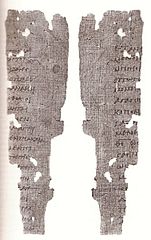Papirus 65

| |
| Data powstania |
III wiek |
|---|---|
| Rodzaj |
Kodeks papirusowy |
| Numer |
|
| Zawartość | |
| Język |
grecki |
| Rozmiary |
18 × 25 cm |
| Typ tekstu |
tekst aleksandryjski |
| Kategoria |
I |
| Miejsce przechowywania |
Narodowe Muzeum Archeologiczne we Florencji |
Papirus 65 (według numeracji Gregory-Aland), oznaczany symbolem – grecki rękopis Nowego Testamentu, spisany w formie kodeksu na papirusie. Paleograficznie datowany jest na III wiek. Zawiera fragmenty 1. Listu do Tesaloniczan, tekst był dwukrotnie publikowany.
Opis
[edytuj | edytuj kod]Zachowały się fragmenty kodeksu z tekstem 1. Listu do Tesaloniczan 1,3-2,1.6-13[1]. Tekst pisany jest w 29 linijkach na stronę, ok. 42 liter w linijce[2]. Rękopis sporządzony został przez profesjonalnego skrybę[3].
Rękopis wyszedł spod tej samej ręki co (zawiera fragmenty Listu do Efezjan), rozmiary kart oraz liczba linijek tekstu na stronę są identyczne i dlatego sugerowano, że mogły stanowić ten sam rękopis[4]. Jedynie liczba liter w linijce tekstu nieznacznie się różni. Oryginalny kodeks mógł zawierać pełny zbiór Listów Pawła[3].
Nomina sacra pisane są skrótami.
Według Alanda jest jednym z trzech wczesnych rękopisów 1. Listu do Tesaloniczan[5].
Tekst
[edytuj | edytuj kod]Tekst grecki rękopisu reprezentuje tekst aleksandryjski, Kurt Aland opisał go jako "strict text", jednak z pewnym wahaniem, ponieważ fragment jest zbyt krótki. Tekst rękopisu zaklasyfikował do kategorii I[1]. Hatch i Welles określili go jako tekst aleksandryjski[2].
Historia
[edytuj | edytuj kod]Fragment prawdopodobnie pochodzi z Oksyrynchos[2]. Tekst rękopisu opublikowany został w 1957 roku, przez Vittorio Bartolettiego (1920-1990)[6], następnie przez Comforta. Kurt Aland umieścił go na liście rękopisów Nowego Testamentu, w grupie papirusów, dając mu numer 65[7].
Philip Comfort datuje na połowę III wieku[2]. Rękopis datowany jest przez INTF na wiek III[1].
Obecnie przechowywany jest w Narodowym Muzeum Archeologicznym (PSI 1373) we Florencji[1].
Zobacz też
[edytuj | edytuj kod]Przypisy
[edytuj | edytuj kod]- ↑ a b c d K. Aland, B. Aland: The Text of the New Testament: An Introduction to the Critical Editions and to the Theory and Practice of Modern Textual Criticism. przeł. Erroll F. Rhodes. Grand Rapids, Michigan: William B. Eerdmans Publishing Company, 1995, s. 100. ISBN 978-0-8028-4098-1.
- ↑ a b c d Comfort i Barrett 2001 ↓, s. 355.
- ↑ a b Comfort i Barrett 2001 ↓, s. 358.
- ↑ Klaus Wachtel, Klaus Witte, Das Neue Testament auf Papyrus: Gal., Eph., Phil., Kol., 1. u. 2. Thess., 1. u. 2 Tim., Tit., Phlm., Hebr, Walter de Gruyter, 1994, p. LXI.
- ↑ K. Aland, B. Aland: The Text of the New Testament: An Introduction to the Critical Editions and to the Theory and Practice of Modern Textual Criticism. przeł. Erroll F. Rhodes. 1995, s. 85. ISBN 978-0-8028-4098-1.
- ↑ Vittorio Bartolotti, Papiri greci e latini della Società Italiana XIV, (1957), pp. 5-7.
- ↑ K. Aland, B. Aland: The Text of the New Testament: An Introduction to the Critical Editions and to the Theory and Practice of Modern Textual Criticism. przeł. Erroll F. Rhodes. 1995, s. 74. ISBN 978-0-8028-4098-1.
Bibliografia
[edytuj | edytuj kod]- Vittorio Bartoletti, Papiri greci e latini della Società Italiana XIV, (1957), pp. 5–7.
- Naldini, Documenti, no. 17.
- Philip W. Comfort, David P. Barrett: The Text of the Earliest New Testament Greek Manuscripts. Wheaton, Illinois: Tyndale House Publishers Incorporated, 2001, s. 355–361. ISBN 0-8423-5265-1, ISBN 978-0-8423-5265-9. (ang.).
Linki zewnętrzne
[edytuj | edytuj kod]- INTF: Papirus 65 (GA). [w:] Liste Handschriften [on-line]. Münster Institute. [dostęp 2017-01-17].
Text is available under the CC BY-SA 4.0 license; additional terms may apply.
Images, videos and audio are available under their respective licenses.


